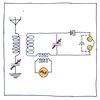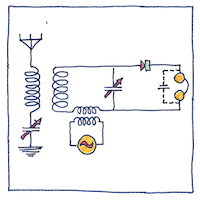Reginald Fessenden
electromagnetism

|
Heterodyne
To broadcast Morse code signals, a radio wave is turned on for different intervals to signify dashes and dots. However, to broadcast voice or music the signal must modify a continuous radio wave. Amplitude modulation of a radio frequency requires shifting the message frequency and combining it with the frequency of the continuous radio wave. This process is called heterodyning. For transmitting, the message frequency is combined with the carrier frequency; for receiving, the carrier frequency is subtracted from the signal resulting in a message shifted to the audio range.
Heterodyning
Theremins heterodyne the variable capacitance of the musician’s hand to produce a corresponding audible tone. Frequency division multiplexing heterodynes hundreds of channels into different frequencies to share the same optical fiber. Superheterodyne receivers heterodyne the radio frequency that you select into an intermediate frequency that is processed so you can hear it
No one knows
No one else can tell what goes on in my head. All I know is that I call “red” whatever’s labeled by that adjective. In between, the color doesn’t persist, only something different that represents it.



Heterodyne detection could reveal communication broadcasts from outer space from a ancient, superior, alien race of beings, if, that is, such a race, and such broadcasts were to be sent within the range of our receivers. The universe produces a lot of noise. Heterodyne processing of the noise itself can reveal both random and non-random processes.
See also in The book of science:
Readings in wikipedia: